Grass spiders! Most probably, you have heard of them, and it is possible that you might have confused them with hobo or wolf spiders. Nevertheless, if you live in North America, you have probably come across one. As evident by the name, grass spiders inhabit grassy areas. They do, however, occasionally enter into residences and establishments.
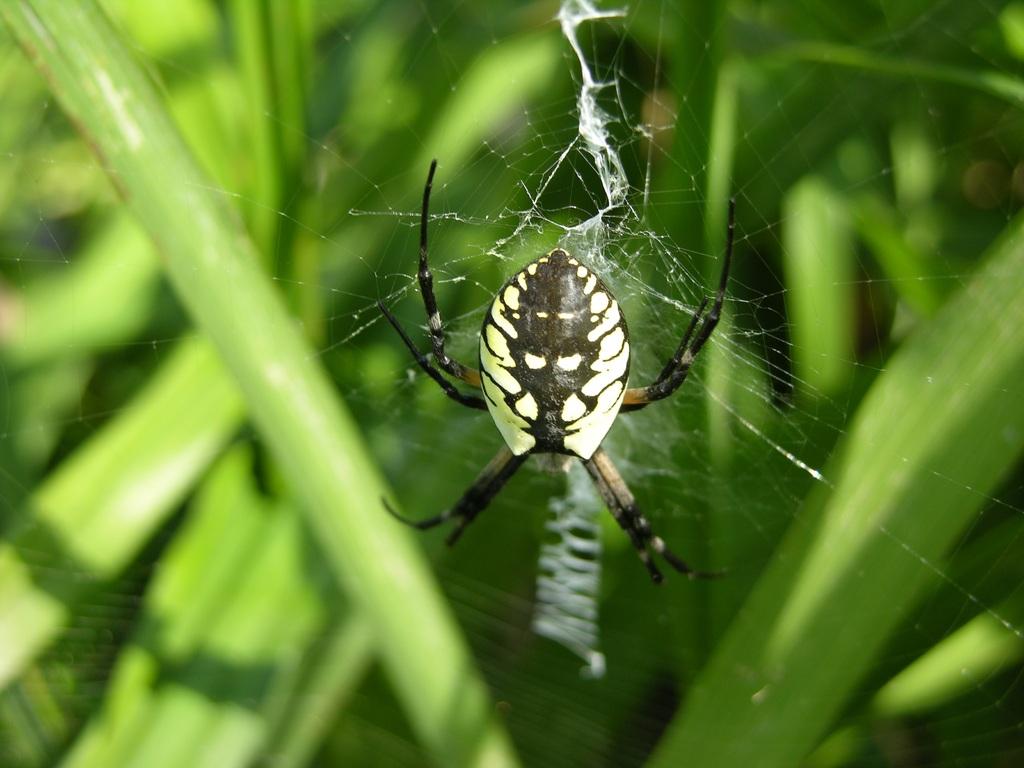
Now, if you ask a gardener or a lawn owner about grass spiders, they have mixed feelings. On the one hand, grass spiders control pests and devour troublesome insects on the lawn. However, on the other hand, no one enjoys snagging their fingers into a spider web or watching a grass spider creep across the kitchen floor.
So, how do you rid your lawn of grass spiders?
Trim back any overgrown vegetation surrounding your home, and maintain a short height for your turfgrass by mowing it regularly. This will minimize the amount of cover that grass spiders have to hide under. Also, manually remove spider webs and clean your yard to get rid of food particles and any other organic debris that attracts grass spiders and other insects that they eat.
Even if you don’t mind having spiders on your lawn, their propensity for creating webs can be annoying. In addition, grass spiders frequently abandon their webs in the fall and move indoors in search of warmth. So, stay with us, and we will tell you everything you need to know about grass spiders and how to get rid of them!
What Are Grass Spiders?
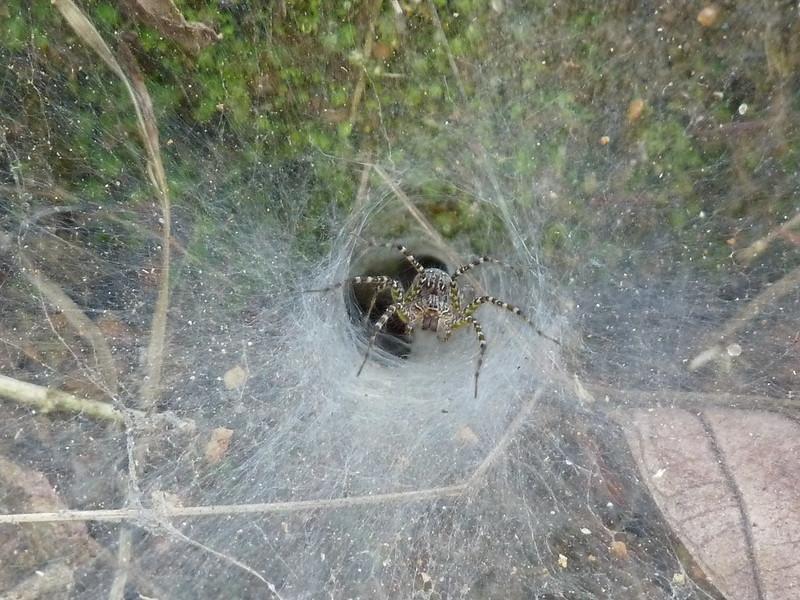
First things first! Before we move on to our main topic, it is essential to understand what grass spiders are. It will help you deal with these pesky insects better and more effectively. Grass spiders are one of the roughly 1,200 known species in the family Agelenidae of spiders. Spiders in this family are famous for funnel-weaving abilities.
Grass spiders spin funnel-shaped webs near the ground to catch their food. The construction of these webs makes it impossible for the prey to escape even though they are not sticky. Grass spiders are very agile and fast movers, and when an insect wanders into the web, they quickly pounce and drag their catch into the funnel.
Grass Spiders are frequently confused with Hobo or Wolf Spiders as the color pattern near their head region, i.e., cephalothorax is very similar. However, a grass spider is not venomous and is not likely to bite. Nearly every lawn has some grass spiders; if not for rain or dew, most people would never realize how many grass spiders they have.
RELATED: Spider Mites on Houseplants: How to Identify and Manage Them?
What Do Grass Spiders Look Like?
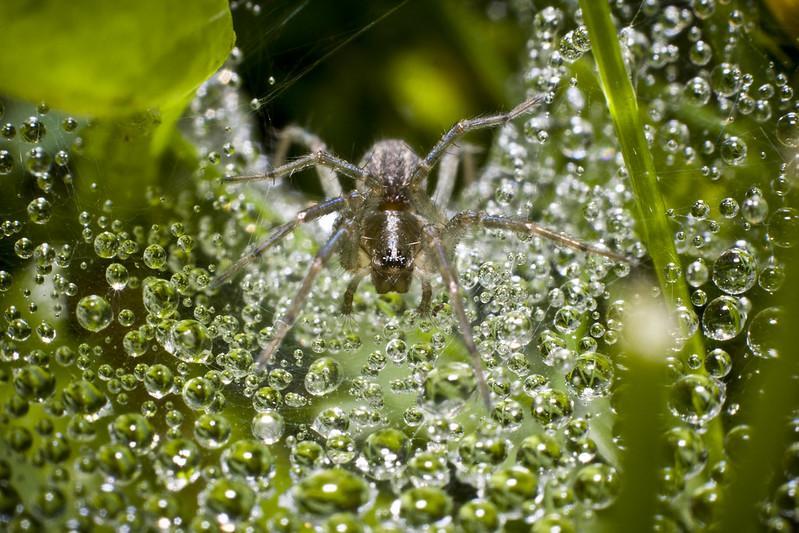
Grass spiders are frequently mistaken for hobo and wolf spiders because they resemble each other significantly. Examining a grass spider’s distinguishing characteristics is the best method for identifying a grass spider. Grass spiders have spherical heads, brown bodies with faint patterns on the abdomen, and eight big eyes grouped in two rows.
Female grass spiders are larger than males and range in length from 10 to 20 mm, whereas males are 9 to 18 mm in size. The front two pairs of a grass spider’s legs are significantly longer than the back pair, allowing it to blend in nicely with tall grasses.
Grass spiders spend a lot of time on grass, but they have been known to weave their webs in other places as well, including leaf piles, mulch, crevices along hardscape and gravel surfaces, and even the window wells of buildings.
Are Lawn Spiders The Same As Grass Spiders?
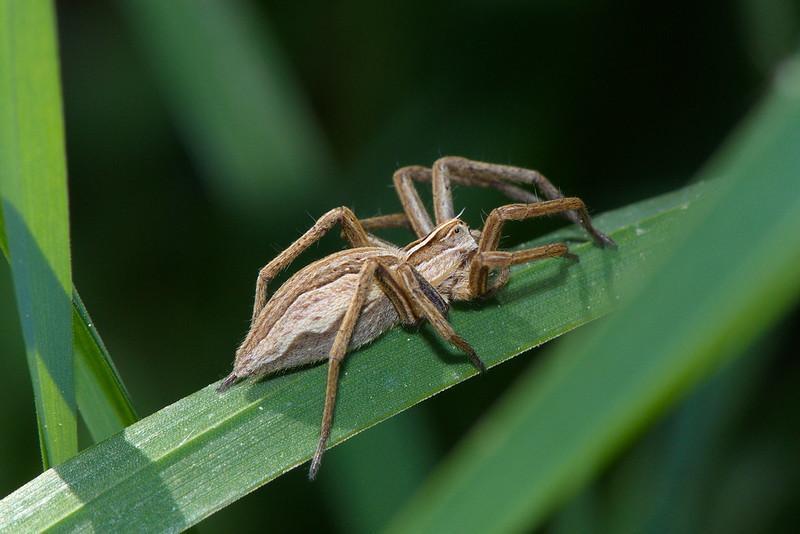
Lawn spiders and grass spiders are frequently mistaken for one another. However, there are some significant distinctions between the two.
For starters, grass spiders are smaller than lawn spiders. Also, their more pronounced body markings can distinguish lawn spiders from other spiders. In addition, lawn spiders are more frequently observed in places like parks, sports fields, and golf courses, where lawns are regularly maintained and taken care of.
Grass spiders, on the other hand, are primarily found in unmanaged or uncultivated places.
Lawn Spider Identification
There could be various types of spiders in your yard; it is vital that you recognize them since doing so will enable you to tell which ones are venomous and which are not. However, remember that if trees and bushy places surround your lawn, there may be many more varieties of spiders on your lawn than the ones we’ve included here.
Grass Spider (Agelenopsis spp)

Grass spiders belong to the Agelenidae family of spiders, which signifies that they construct webs in the shape of funnels. These striped and brown spiders can grow to a length of around one inch. They make their home in dense bushes and shrubs, as well as in tall grasses and other types of ground cover. These spiders create non-sticky nests with their huge spinnerets, which look similar to a tail, hoping to catch a meal.
Grass spiders feature a pair of wide, black, brown bands running lengthwise close to a lighter central band on their slightly hairy and roundish carapaces. These bands are separated by a lighter band and are the best way to identify grass spiders.
The legs are light beige in color with a dark yellowish-brown pattern. The abdomen is elongated and brown, and it has a broad, zigzag stripe that is reddish-brown in hue and has a cream-colored border on both sides.
Hobo Spiders
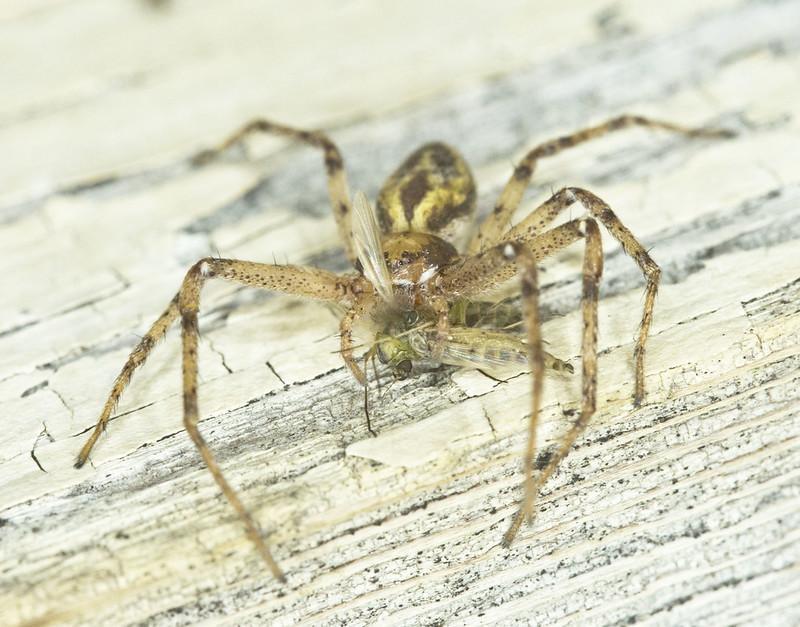
Hobo spiders, like grass spiders, are funnel-web spiders that can be found in and around your home, especially in yards and lawns. They are widespread in the northwest regions of the country. Typically, a hobo spider has a brighter color than a grass spider. It also lacks the same patterns on its back that a grass spider would have.
Grass spiders are often only found in lawns and other vegetation areas, whereas hobo spiders are likely to infiltrate homes & buildings. Because of the variety of brown tones that it possesses, people often mistake this for another spider. By its appearance, you could even be fooled into thinking it’s a brown recluse or a wolf spider.
Wolf Spiders
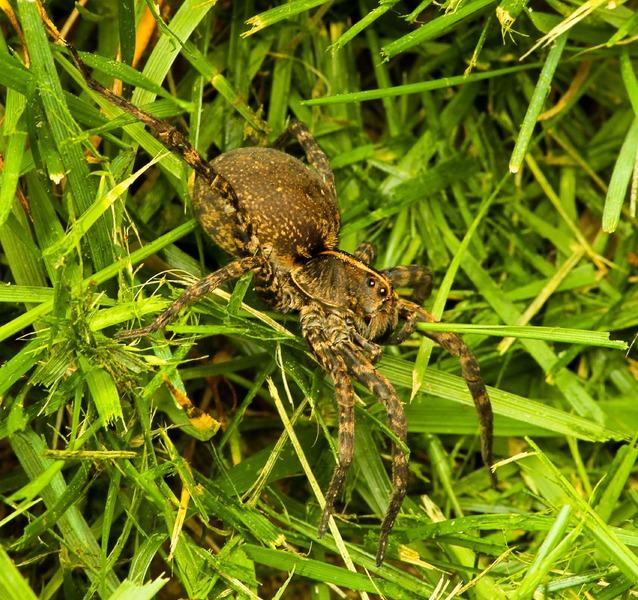
Wolf Spiders have markings all over their bodies that help them blend into their surroundings. Because of this, they are able to effectively conceal themselves within their natural surroundings and escape unnoticed. Wolf spiders are most commonly found in grassy, open places such as yards, fields, and pastures.
Wolf spiders may be drawn to your yard if the soil in your lawn is loose, porous, or otherwise well-aerated. This soil makes for an easy surface for the spiders to dig into and construct their webs and houses. Also, wolf spiders might move in and make those holes their homes if you aerate your soil by putting little holes in it.
They do not have the ability to spin webs; instead, they burrow underground. They can also be found below yard garbage, in mulch, flower beds, shrubbery, in or around firewood, and flower beds and mulch. Inside, they are often found in the areas around doors and windows, as well as in basements, hiding under clutter.
RELATED: Types of White Spiders – A Complete Identification Guide, Fun Facts and more
Here is a table to help you differentiate between the spider types mentioned above:
| Feature | Feature | Hobo Spider | Wolf Spider |
|---|---|---|---|
| Family | Agelenidae | Agelenidae | Lycosidae |
| Body Size | 10 to 20 mm | 7 to 14 mm | 10 to 35 mm |
| Color | Multiple shades of brown | Multiple shades of brown | Yellow, brown, or gray |
| Pattern | Large & prominent spinnerets Two wide dark bands on the back | Patterns vary a lot Patterns display colors of light & dark brown | Thick black line down the abdomen |
| Spinnerets | Long | Short | Short |
| Type of Web | Funnel webs | Funnel webs | No webs |
| Venom | Low | Low | High |
| Live In | North America | Pacific North-West | Worldwide |
How Do I Get Rid Of Spiders On My Lawn?
Most of the spiders in your yard won’t harm you in any way. In fact, they are generally helpful because they feed on hazardous insects like mosquitoes and other similar lawn pests. However, if you have reason to believe that the grass in your yard is home to venomous types of spiders, you should look into treatment options.
In most cases, professionals advise against taking any active steps to remove these spiders from lawns. Nevertheless, here are a few of them described in detail:
Use Diatomaceous Earth
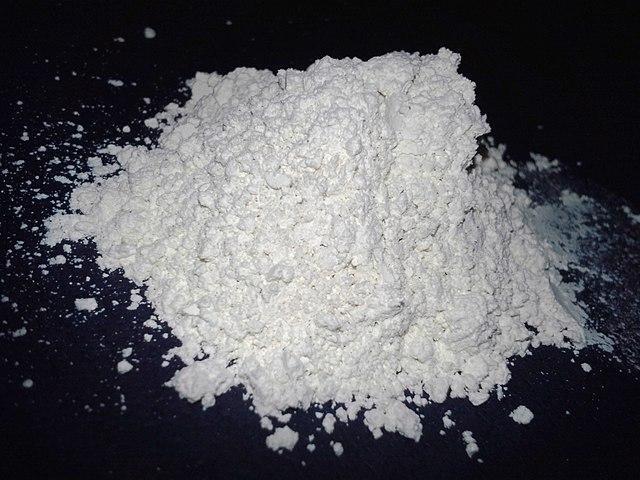
Grass spiders may easily establish a home for themselves in tall grasses, weeds, and brush heaps. Food scraps left behind by humans are a magnet for the insects that spiders feed on. To get rid of these pesky lawn spiders, you can use diatomaceous earth, a substance created from various aquatic animals’ fossils.
It is dangerous to insects and spiders, but not to humans or other animals. Since diatomaceous earth kills spiders by physically drying them out, its effectiveness does not diminish as long as it is kept dry. The use of diatomaceous earth for spider control is a straightforward process. It is as simple as spreading a uniform layer over any potential hiding spots or travel routes for spiders in your yard.
The diatomaceous earth will remain effective for as long as it is in place, so if you have a persistent spider problem, you will need to reapply it frequently. However, it must be mentioned that while diatomaceous earth is not dangerous, it might irritate people. Therefore, it’s crucial to use caution when using it.
Use Insecticides
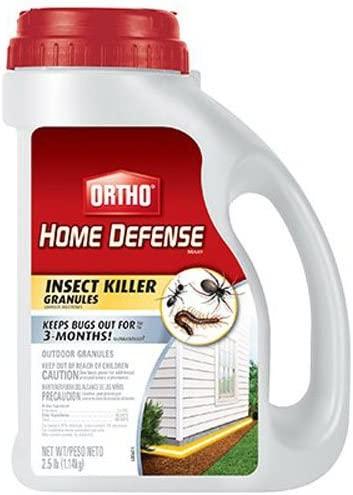
Photo by amazon
The presence of spiders in your yard is likely due to the abundance of food and organic matter. As I’ve already mentioned, grass spiders and several other species of spiders feed on insects. Therefore, if there are a lot of insects on your grass, there will also be a lot of spiders crawling around it. Applying an insecticide to your grass will help you get rid of spiders by reducing the number of insects there are to feed on.
Verify, though, that the organism you’re trying to eradicate actually is causing harm to your lawn. Also, remember that most pests, even with pesticides, cannot be eliminated entirely. Moreover, pesticides should only be used as a last resort to get rid of grass spiders because they can also kill pollinators and other beneficial insects.
Here is a list of my favorite insecticides to use on a lawn:
- Ortho Home Defense MAX Insect Killer
- Amdro Kills Ants & Spiders Granules
- Wet & Forget Miss Muffet’s Revenge Indoor and Outdoor Spider Killer
Trim Vegetation

The overgrown vegetation in your yard likely is to blame for an ongoing grass spider infestation. Unfortunately, some species of spiders like to make their homes in areas with lots of vegetation. Therefore, in addition to regularly mowing your lawn, remove and keep in check other forms of vegetation as well, both in and around your yard.
Ensure all bushes, hedges, and flowering plants are kept nice and clipped. In addition, it is also essential to clear your lawn of trash and leaves, as these things serve as a breeding ground for pests and places to hide.
Remove Spider Webs Regularly
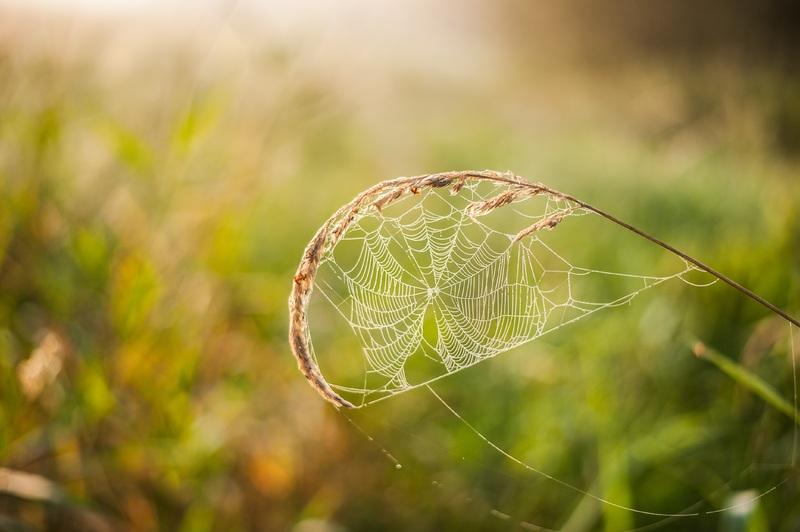
Simply doing some clean-up work on the lawn is all that is required to get rid of the webs that grass spiders have spun. In addition, remove anything that could attract insects, such as brush piles, food crumbs left behind after eating outside, or pet food left outdoors. Finally, when you discover spider webs, sweep them away with a broom.
Even though this won’t kill the spiders, it will make your lawn a less desirable place for them to live. In addition, you can use a leaf blower or a sprinkler set to a high-pressure setting to destroy and remove spider webs from your lawns.
Avoid Eating & Drinking In The Yard

Spiders and other insects are drawn to sugary beverages such as soda and other sweet liquids and food that is accidentally left on the grass. Ants are particularly attracted to sugar, and it’s quite likely that if you have a problem with ants, you’ll also have a problem with grass spiders as well since ants and grass spiders are natural enemies.
Additionally, spiders and other insects that live on lawns go absolutely crazy for dog food that is left out there. If at all feasible, the dog food should be stored inside the home, and the only bowl that should be kept outside should be the water bowl. The same principle applies to dog bones and treats as well.
Reduce Outdoor Lighting

Insects and other unpleasant pests are drawn to the light of outdoor lighting. If using less outside lighting results in fewer insects and other pests, then the number of spiders will likely decrease as well. In the event that you are insistent on having outside lighting, yellow lighting is the most effective option for warding off bugs.
Final Thoughts | Grass Spiders
Lawn spiders may be unwelcome, but it’s vital to understand that the lawn is also home to other insects that don’t harm your grass. Although using a pesticide can get rid of the spiders, it might cause much more harm than you anticipate. This is because the release of organic fertilizer and the breakdown process can be slowed down by the toxin in the pesticide, which can also soak through the soil and kill significant soil organisms.
Therefore, you may rest easy knowing that grass spiders won’t harm your lawn. Most grass-dwelling spiders weave webs to trap their meal, so your yard won’t be directly affected. Even with all of this in mind, it is still very reasonable to want to get rid of the spiders on your lawn so you can unwind and enjoy your time outside without being concerned or afraid.
Frequently Asked Questions (FAQs)
Why are there so many spiders on my lawn?
There are species of spiders that like to make their homes in areas with lots of vegetation. The overgrown vegetation in your yard likely is to blame for the grass spider infestation. Regularly trimming the plants around your home will help eliminate and prevent lawn spiders. This will also leave the area looking neat and well-kept.
Can spiders damage your lawn?
Grass spiders are beneficial because they reduce the number of lawn insects, which, if allowed to proliferate unchecked, might cause irreparable damage to grasses. However, if there are too many grass spider webs, it can give the impression that the lawn has not been maintained. And if the conditions are ideal, a grass spider will bite.
What attracts spiders to your yard?
Gardens that provide a lot of places to hide are more likely to have spiders. To a spider, a pile of wood, rocks, compost, or any other kind of trash will appear to be an inviting and secure place to live. Eliminating them from your yard will assist in preventing spiders from invading your garden, lawn, or yard.
How do I identify a grass spider?
In addition to the unusual webs that grass spiders construct (funnel webs), they can be recognized by the highly extended spinnerets on their hind legs and the dorsal markings that are present on their carapace and abdomen.
What spider lives in a hole in the ground?
Burrowing wolf spiders build vertical tunnels and dwell in them for the entirety of their lives, or in the case of males until they mature and begin to wander in search of mates. Also, wolf spiders can invade and inhabit plug holes if you use a plug aerator on your lawn.
Sources for Further Reading
Funnel Weavers & Grass Spiders – University of Kentucky Department of Entomology – Kentucky Critter Files
I Spy a Spider: Common Spiders Around the Home – University Of Nebraska–Lincoln Extension Service
House Invader Spiders – Iowa State University Extension and Outreach







